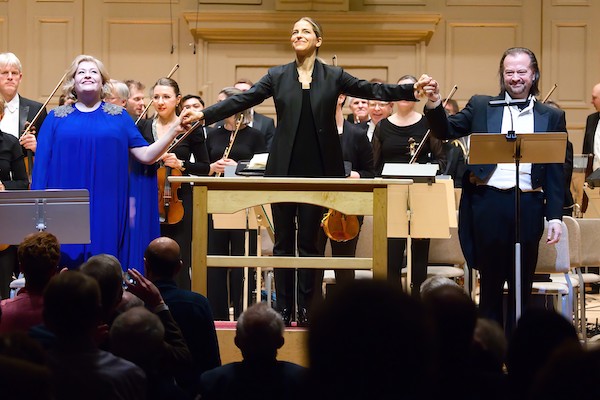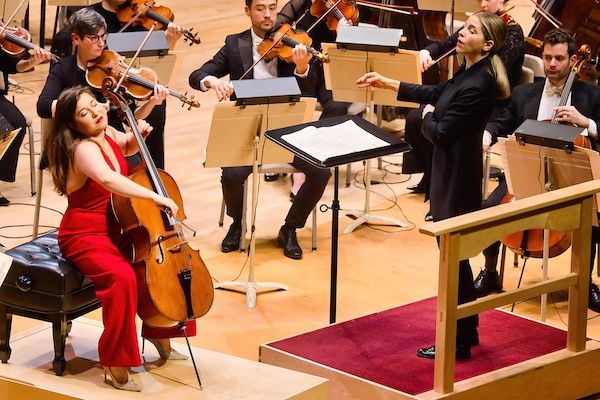Classical Concert Review: Karina Canellakis Conducts Bartók and Haydn
By Aaron Keebaugh
Karina Canellakis’s tour through Bartók’s Bluebeard’s Castle showed why she remains a conductor who continues to exercise a remarkable interpretive power.

Karen Cargill, Karina Canellakis, and Nathan Berg take their bows this past weekend at Symphony Hall. Photo: Hilary Scott
The most important thing about conducting, Otto Klemperer relayed in 1973, is to let the orchestra breathe.
That observation has largely held sway with the numerous guest conductors who have stood before the Boston Symphony Orchestra. In their own way, each has struck a balance between sweep and stasis, urgency and calm. But for Karina Canellakis, the energy between those dynamic poles flows back and forth with a natural ease.
Attaining that spontaneity was even more remarkable given her program with the BSO this past weekend. The performance of Haydn’s Cello Concerto in C was the very picture of dynamism and flair — an unusual approach to a work of Viennese classicism. But Canellakis’s tour through Bartók’s Bluebeard’s Castle showed why she remains a conductor who continues to exercise a remarkable interpretive power.
The New York–born conductor has been a regular guest of the BSO’s since 2021. Yet her star was on the ascent before then. Now, serving as chief conductor of the Netherlands Radio Philharmonic Orchestra, she has delved into a host of large-scale projects — including performances of several of Leoš Janáček’s operas.
Yet Bartók’s music has also become a specialty for Canellakis, as her recent recording of the Four Orchestral Pieces and Concerto for Orchestra attests. She favors lithe textures in lieu of brazen force. Her sprightly tempos generate live-wire intensity.
But in Bluebeard’s Castle she lingered in the music’s darkness and mystery to convey the psychological horrors of Béla Balázs’s libretto. The opera begins with newlyweds Judith and Duke Bluebeard’s arrival to his remote castle. Judith presses Bluebeard to open all of the doors in his home, hoping to shed light on his secretive past. Despite her husband’s protests, she wins him over, though each door reveals as many fresh terrors as wonders. Opening the final door, Judith finds his three former brides preserved for all time. Bluebeard crowns her the most beautiful of his spouses — before she joins them.
This chilling tale of vanity and serial murder was well served by Canellakis’s successful tightrope act, which balanced long-building tension with eerie stasis. Crescendos erupted, and powerful statements which signaled that surfaces in this troubling story were not always as they appeared. When Canellakis shed light into the murky corners of Bluebeard’s castle (and psyche), the music seemed to glow from a distance — as much a symbol of inner coldness as stoic assurance. Through it all, the BSO played the most crucial role, supplying a mordant canvas onto which the two singers could splash waves of vocal color.

Alisa Weilerstein plays Haydn’s Cello Concerto in C with the BSO and conductor Karina Canellakis. Photo: Hilary Scott
Both guest singers were excellent, aside from momentary lapses. Karen Cargill’s mezzo soprano colorfully dramatized Judith’s incessant hankering for the truth buried in her new husband’s enigmatic past. Her high notes rang with the excitement of new discovery; lower tones conveyed a bewildered withdrawal into despair. Only a few issues with balances marred the overall performance; unfortunately, the brass drowned Cargill out at several climactic points.
Duke Bluebeard is often portrayed as a menacing and calculating predator. But Nathan Berg sang with a hint of warmth that revealed surprising flickers of tenderness and care. In Berg’s interpretation, the Duke was both perpetrator and victim, doomed to be caught up in his obsessions.
Jeremiah Kissel delivered the opening narration with resonant conviction. “Where is the stage?” he asked rhetorically as the orchestra sounded the opening strains. “Is it outside or inside?” Thursday’s performance explored the depths and wayward tensions of both perspectives.
The concert opened with Haydn’s Cello Concerto in C, spotlighting Alisa Weilerstein as soloist.
This music is prototypical Haydn: bright, buoyant, and teeming with a terpsichorean vitality that percolates beneath the flowing melodies. But Weilerstein played with a rich and colorful exuberance that transformed the Classical-era score into a Romantic-style showstopper. Her figures in the first movement rose and fell with seismic urgency. Her lines in the second soared. The finale generated the most intensity, with Weilerstein and Canellakis working in ideal tandem.
Weilerstein’s encore, the Sarabande from Bach’s Cello Suite in E-flat major, was just as invigorating. Poised between extremes of lyricism and verve, her performance painted an ideal picture of serenity and grace.
Aaron Keebaugh has been a classical music critic in Boston since 2012. His work has been featured in the Musical Times, Corymbus, Boston Classical Review, Early Music America, and BBC Radio 3. A musicologist, he teaches at North Shore Community College in both Danvers and Lynn.
Tagged: Boston Symphony Orchestra, Karen Cargill, Karina Canellakis
